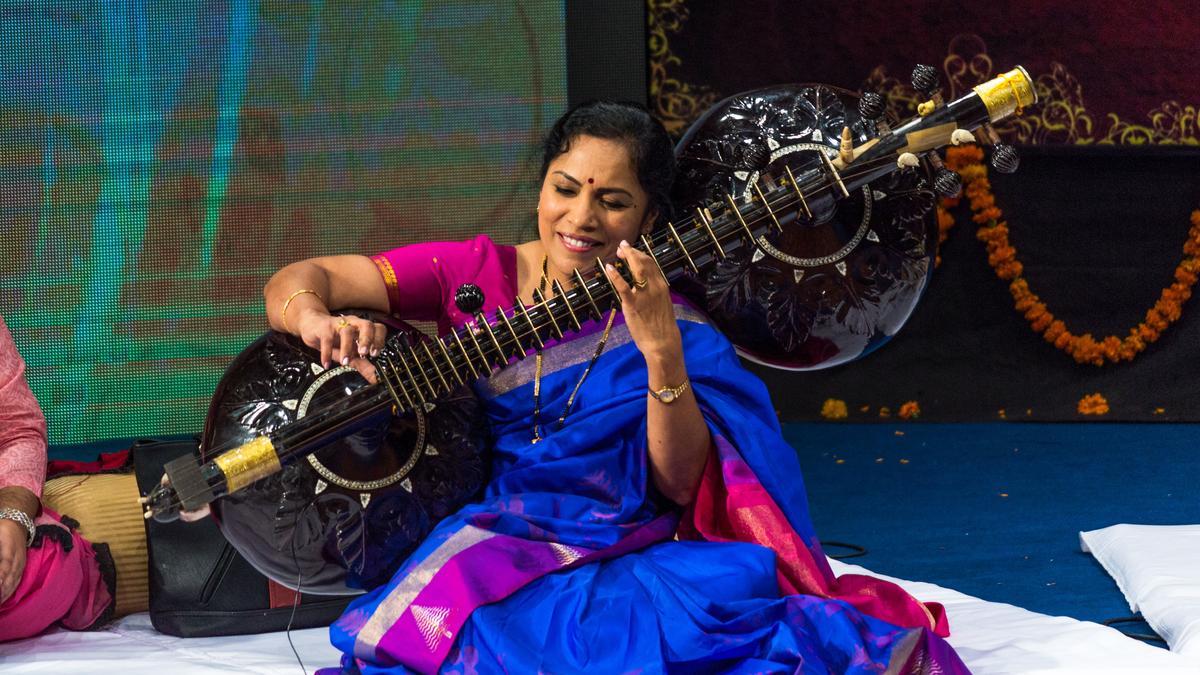As Jyoti Hegde sat on the stage at a recent event organised by the Sangeet Natak Akademi to celebrate World Music and International Yoga Day in Delhi, what caught the eye was the beautifully crafted instrument in her hands. It looked like the veena, but not totally. It was the rudra veena, and Jyoti Hegde is the only woman rudra veena artiste. She was an apt choice for the event because the rudra veena is the only string instrument that also requires the artiste to practise breath control. Underlining the need to do yoga for the same, Jyoti says since the instrument is based on dhrupad, which lays importance on breath control, it is applicable to the rudra veena too. “It impacts the way the instrument is played and the sound produced.”
The ‘khandar vani’ was the original style of ‘beenkars’ or rudra veena exponents. This was the style practised by Tansen’s beenkar son-in-law, Raja Misri Chand, known as Nababat Khan in the Mughal court of Akbar. Later, Ustad Asad Ali Khan rose to be one of the finest rudra veena artistes, hailing from a family dedicated to this instrument. Jyoti is his foremost disciple. Associated with lord Shiva, and the rudra veena is only string instrument that also requires the artiste to practise breath control. Jyoti was
The rudra veena has always had a mysticism attached to it, being taught only to a chosen few and said to be unlucky for those who did not follow the tradition when playing it. In fact, the instrument sursingar was invented in the 18th Century, to teach this style of rudra veena playing (baaj) to other string instrumentalists such as rabab or sarod.
Jyoti Hegde is the only woman rudra veena artiste
| Photo Credit:
Narendra Dangiya
At the concert, Jyoti presented raag Bairagi Bhairav. A relatively obscure raga, she learnt it not from the ustad, but from Bindu Madhav Pathak, a sitar and rudra veena exponent from Kirana gharana, under whom Jyoti initially trained. The raag was re-introduced by Pt. Ravi Shankar and is similar to Carnatic raga Revathi. Jyoti had composed a chautaal (12 beat) ‘gat’ (composition) in the raag. Serene, and meditative, Jyoti’s music never fails to soothe.
During a post-performance conversation, Jyoti revealed she did not hail from a family of musicians. When she began learning, she could not identify the difference between dhrupad and khayal, and used to play bandish on the veena. Though the ustad dissuaded her from pursuing the rudra veena, Jyoti was insistent. “When I heard the sound of instrument, I found my calling. The note resonated deep within me and I knew I had to learn it.”
Marriage and motherhood did not deter Jyoti from expanding her musical horizons. More so, since she was in Dharwad, home to many music stalwarts. She attended lec-dems by Pt. Indudhar Nirody of the Agra gharana, who helped hone her skills. He also made her understand that the rudra veena lent itself only to dhrupad. She was 35 then, and was all set to forge ahead in her musical journey.

Jyoti with her guru, Ustad Asad Ali Khan
| Photo Credit:
Special Arrangement
Jyoti approached Ustad Asad Ali Khan, he refused to teach her, saying the rudra veena was not meant for women. She persisted for a year, travelling across the country to meet him at every concert of his. He finally agreed, but said she had to learn breath control, and enunciate the sound of ‘aum’ from the ‘nabhi’ (navel). “‘Only then ‘will you be able to handle the instrument’ he had said,” shares Jyoti, who took six months to achieve this. Then came the next challenge, to sit in vajrasana to play the instrument. Jyoti struggled, when the pakhawaj maestro Pt. Dal Chand Sharma, a friend of the ustad intervened and finally, the ustad agreed to teach her.
Jyoti shares how she would travel by train for two days to reach Bombay to meet the ustad. “It was not at all easy to connect with him. In spite of all the challenges, learning from the ustad was a memorable experience. Meals were forgotten during the class and later, the ustad would ensure a vegetarian meal was served to me. Once, he even missed his flight as he was so engrossed in teaching, when I reminded him of the time, he chided me saying, ‘focus on the music’.”
The learning lasted six years, till the demise of Ustad Asad Ali Khan in 2011. She owes it to him. for not just teaching to play the instrument but also to understand its heritage. Today, she is the torchbearer of the tradition that the Ustad represented.
Jyoti now wants to pass on the tradition by teaching young enthusiasts. realises the only way she can repay the debt to him is by teaching others. Though Jyoti lives in a remote village in Sirsi district of Karnataka, she still manages to teach students from across the globe. Some of them visit her for one-on-one training, which also includes working on the farm. “After all art is about training both the mind and the body,” says Jyoti.
Published – July 08, 2025 02:09 pm IST
#Meet #Jyoti #Hegde #woman #rudra #veena #artiste
Ustad Asad Ali Khan ,Beenkar style of veena tradition,Jyoti hegde,Tansen ,Raja Misri Chand,Nababat Khan
latest news today, news today, breaking news, latest news today, english news, internet news, top news, oxbig, oxbig news, oxbig news network, oxbig news today, news by oxbig, oxbig media, oxbig network, oxbig news media
HINDI NEWS
News Source


